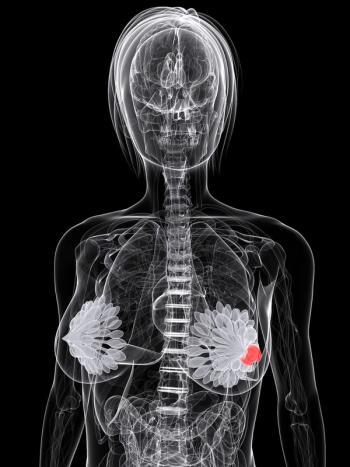
Real-World Analysis of Tucatinib Triplet Yields Positive Safety Profile in HER2+ Metastatic Breast Cancer
Results from the real-world analysis of the phase 2 HER2CLIMB trial showed a good safety profile with the tucatinib triplet regimen in patients with HER2-positive metastatic breast cancer.
Tucatinib (Tukysa), trastuzumab (Herceptin), and capecitabine combination was confirmed to have a positive safety profile in patients with HER2-positive metastatic breast cancer, according to results from the phase 2 HER2CLIMB trial (NCT02614794) which was presented at the
The real-world analysis also verified several drug-drug interactions for tucatinib therapy that could be managed and adjusted with the help of clinical pharmacists.
The HER2CLIMB trial showed an objective response rate of 40.6% (95% CI, 35.3%-46.0%) for all patients who received tucatinib, trastuzumab, and capecitabine. In terms of the safety profile, adverse events (AEs) of any grade were reported in 99.3% of patients and events of grade 3 or higher were seen in 55.2%. Common AEs in those who received the triplet regimen included diarrhea (80.9%), palmar–plantar erythrodysesthesia syndrome (63.4%), nausea (58.4%), fatigue (45.0%), and vomiting (35.9%).2
Investigators from Duke University Medical Center conducted a retrospective, single-center, cohort study of the safety of the tucatinib triplet, looking at the incidence of AEs, the incidence of drug-drug interactions with tucatinib, and the overall response rate (ORR) after initiation of tucatinib therapy.
All patients included in the study were adults with HER2-positive metastatic breast cancer who were started on tucatinib therapy between April 17, 2020, and June 9, 2021, at the Duke Breast Oncology Clinic.
A total of 23 patients were evaluable; themedian age was 55 years (range, 34-83). The most common site of metastasis was the bone in 52% of patients followed by the lung in 43%, the liver in 39%, and the brain (stable in 39%, active in 13%). Patients had received a median of 3 lines of prior therapy (range, 0-6).
The most common AE of any grade observed in the real-world study was fatigue (70%) followed by palmar–plantar erythrodysesthesia syndrome (61%), nausea (61%), anemia (61%), diarrhea (52%), thrombocytopenia (52%), increased aspartate aminotransferase (AST) levels (52%), and increased alanine aminotransferase (ALT) levels (43%). Grade 3 or higher events consisted of increased ALT levels in 13% of patients, increased AST levels in 9%, nausea in 9%, and fatigue, vomiting, increased total bilirubin, and mucositis in 4% of patients each.
Drug-drug interactions were reported in 39% of patients with 12 different treatments. Tucatinib dose modifications were necessary in 26% of patients.
In terms of efficacy, 26% of patients achieved a partial response and 35% had stable disease. Progressive disease was reported in 30% of patients and 9% were unable to determine response.
For patients with stable brain metastases (n = 9), partial responses were observed in 44% and stable disease was achieved by 33%. One patient had progressive disease and was unable to determine response. In those with active brain metastases (n = 3), partial response, stable disease, and progressive disease was seen in 1 patient each (33%).
In patients who required a reduction of capecitabine dose (n = 18), partial responses were reported in 39% of patients, stable disease in 33%, progressive disease in 22%, and unable to determine response in 6%.
According to prior therapy use, among 17 patients with prior trastuzumab emtansine (Kadcyla) exposure, partial responses were seen in 24% and stable disease in 41%. With prior neratinib (Nerlynx) exposure (n = 7), partial response was reported in 14% of patients and stable disease in 29%. Three patients had previously received trastuzumab deruxtecan (Enhertu), and no responses or stable disease was observed in these patients. With prior everolimus (Afinitor) or a CDK4/6 inhibitor (n = 3 each), 1 patient each had stable disease and progressive disease was observed in the remaining patients. With lapatinib (Tykerb) (n = 2), 1 patient had a partial response and the other had progressive disease.
The study authors noted that the “tucatinib, trastuzumab, and capecitabine regimen sequential place in therapy varied among patients. No patients with previous trastuzumab deruxtecan or omission of capecitabine experienced a partial or stable disease response.”
DiCola et al concluded that further data were needed regarding sequencing for the regimen and its impact on therapy efficacy.
References
- 1. DiCola C, Anders C, Sammons S, Parish A, Erkanli A, Moore H. Evaluating the safety of tucatinib in combination with trastuzumab and capecitabine for human epidermal growth factor 2 (HER2)-positive metastatic breast cancer in a real-world setting. Presented at: 2022 San Antonio Breast Cancer Symposium; December 6-10, 2022; San Antonio, TX. Abstract P4-01-10.
- 2. Murthy RK, Loi S, Okines A, et al. Tucatinib, trastuzumab, and capecitabine for HER2-positive metastatic breast cancer. N Engl J Med. 2020;382:597-609. doi:10.1056/NEJMoa1914609
Newsletter
Stay up to date on recent advances in the multidisciplinary approach to cancer.
















































































